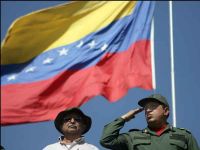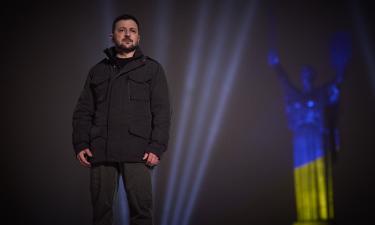French Newspaper Announces Plans to Invade Venezuela
By Ignacio Ramonet

The coming to power in Venezuela, of President Hugo Chávez on February 2, 1999 coincided with a traumatic event for the U.S. military: the closure of its main military installation in the region, the Howard base, located in Panama, closed under Torrijos-Carter (1977). In its place, the Pentagon selected four locations to control the region: Manta in Ecuador, Comalapa in El Salvador and the islands of Aruba and Curaçao (Netherlands sovereignty).
In its "so to speak," traditional espionage missions, new official duties were added to these bases (monitor drug trafficking and combating illegal immigration into the United States), and other covert tasks: to combat the Colombian rebels, control flows of oil and mineral freshwater resources and biodiversity. But from the beginning, its main objectives were to monitor and destabilize Venezuela and the Bolivarian Revolution.
After the attacks of 11 September 2001, the U.S. Defense Secretary Donald Rumsfeld defined a new military doctrine to meet the threat of "international terrorism". It modified their external deployment strategy, based on the existence of huge bases equipped with numerous staff. He decided to replace these megabases by a much larger number of Foreign Operating Locations (FOL, Operational Site prepositions) and Cooperative Security Locations (CSL, Shared Web Security) with little military personnel, but equipped with ultramodern technologies of detection.
Result: in a short time, the number of U.S. military installations abroad has multiplied, reaching the unprecedented sum of 865 bases or CSL-FOL types deployed in 46 countries. Never before in history, has a power so multiplied their checkpoints to be implemented across the planet.
In Latin America, the redeployment of bases allowed the Manta (Ecuador) to collaborate in the failed coup of 11 April 2002 against President Chavez. Thereafter, a media campaign run by Washington began to spread false information about the alleged presence there of cells of organizations such as Hamas, Hezbollah and even Al Qaeda.
Under the pretext of monitoring such movements, and in retaliation against the government in Caracas that ended in May 2004, a half century of U.S. military presence in Venezuela, the Pentagon extends the use of its military bases on the islands of Aruba and Curaçao, located very near the Venezuelan coast, which have recently been increased by visits of U.S. warships.
This has been denounced by President Chavez recently: "It is good that Europe knows that the American empire is arming to the teeth, with the islands of Aruba and Curacao filled with warplanes and warships . (...) I am accusing the Kingdom of the Netherlands to be laying next to the U.S. empire, an aggression against Venezuela "(1).
In 2006, Caracas starts talking about "socialism of the 21st century", where the Bolivarian Alliance for the Americas (ALBA) was born and Hugo Chávez is reelected president. Washington reacted by imposing an embargo on arms sales to Venezuela, under the pretext that Caracas "does not cooperate sufficiently in the war against terrorism." The F-16s in the Venezuelan Air Force are left without spare parts. In response, Venezuelan authorities established an agreement with Russia to equip its air force with Sukhoi aircraft. Washington denounces it as an alleged "massive rearmament" of Venezuela, omitting to recall that the main military budgets in Latin America are Brazil, Colombia and Chile.
And every year, Colombia receives U.S. military aid of $ 630 million (about 420 million euros).
Going from there, things are accelerating. On 1 March 2008, helped by the Manta base, Colombian forces attacked a camp of the Revolutionary Armed Forces of Colombia (FARC) located within the territory of Ecuador. Quito, in retaliation, decides not to renew the agreement on the Manta base which expires in November 2009. Washington responds, the following month, with the reactivation of the Fourth Fleet (deactivated in 1948, sixty years ago ...) whose mission is to oversee the Atlantic coast of South America.
A month later, the South American nations met in Brasilia, replicated by creating the Union of South American Nations (UNASUR), and in March 2009, the South American Defense Council.
A few weeks later, the U.S. ambassador in Bogota announced that the Manta base will be relocated to Palanquero, Colombia.
In June, with support from the U.S. base in Soto Cano, a coup is produced in Honduras against President Manuel Zelaya, who had managed to integrate his country into ALBA. In August, the Pentagon announced that it will have seven new military bases in Colombia. And in October, the conservative president of Panama, Ricardo Martinelli, admits he has ceded to the United States use of four new military bases.
Thus, Venezuela and the Bolivarian Revolution are surrounded by no less than thirteen U.S. bases located in Colombia, Panama, Aruba and Curacao, as well as aircraft carriers and warships of the Fourth Fleet. President Obama seems to have left hands free to the Pentagon. All are predicting an imminent assault. "Will the people consent to a new crime committed against democracy in Latin America?
Notes:
(1) Speech at the Meeting of ALBA with Social Movements in Denmark, Copenhagen, 17 December 2009.
Translated from Spanish from the Portuguese version by:
Lisa KARPOVA
PRAVDA.Ru
Subscribe to Pravda.Ru Telegram channel, Facebook, RSS!




